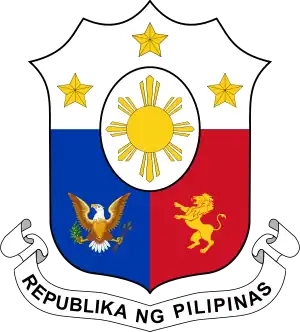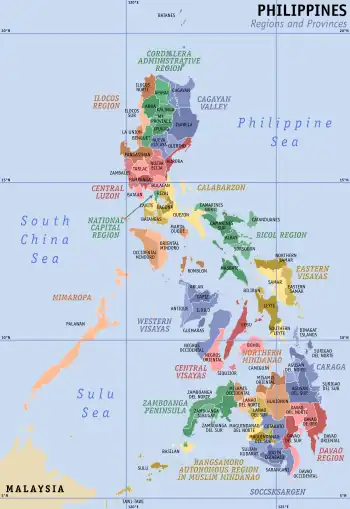| Southern Tagalog Timog Katagalugan Rehiyong Timog Tagalog | |||||||||
|---|---|---|---|---|---|---|---|---|---|
| Former region of the Philippines | |||||||||
| 1965–2002 | |||||||||
.svg.png.webp) Location within the Philippines | |||||||||
| Capital | Quezon City[1] (Regional Center) | ||||||||
| Population | |||||||||
• 2000[2] | 11,793,655 | ||||||||
| History | |||||||||
• Established | January 1, 1965 | ||||||||
• Disestablished | May 17, 2002 | ||||||||
| Political subdivisions | 11 provinces at the time of partitioning | ||||||||
| |||||||||
| Today part of | |||||||||
Southern Tagalog (Filipino: Timog Katagalugan, also known colloquially as Rehiyong Timog Tagalog), designated as Region IV, was an administrative region in the Philippines that comprised the current regions of Calabarzon and Mimaropa, the province of Aurora of Central Luzon (then part of Quezon Province until 1979), and several cities of Metro Manila (formerly part of Rizal, except for Valenzuela, which was part of Bulacan, and for Quezon City and Pasay which were and are independent cities). The name remains as a cultural-geographical region only, which exempts Aurora.
The region is bordered by Manila Bay and West Philippine Sea to the west, Lamon Bay and the Bicol Region to the east, the Tayabas Bay, Sibuyan Sea, and Balabac Strait which is a maritime border with Sabah, Malaysia to the south, and Central Luzon to the north.
It was partitioned into the two regions on May 17, 2002.[3]
History
Southern Tagalog was the largest region in the Philippines in terms of both land area and population. The 2000 Census of Population and Housing showed the region having a total of 11,793,655 people, which comprised 15.42 percent of the 76.5 million population of the country at that time.[2][4]
Quezon City was the designated regional center of Southern Tagalog.[1]
The former region covered the area where many reside; the two other majority-Tagalophone regions are the National Capital Region and Central Luzon.
On September 7, 1946, Republic Act No. 14 changed the name Tayabas to Quezon; both Quezon City & Quezon Province were named in honor of Manuel L. Quezon, the Commonwealth president who was born in Baler, which was one of the province's towns.[5]
In June 1951, the northern area of Quezon (specifically, the towns of Baler, Casiguran, Dilasag, Dingalan, Dinalungan, Dipaculao, Maria Aurora and San Luis) was made into the sub-province of Aurora.[6] Aurora was named of the president's wife, Aurora Quezon, also a native of Baler. Aurora was finally separated from Quezon as an independent province in 1979, and added to Southern Tagalog.[7]
Partitioning
Region IV or Southern Tagalog was divided into Calabarzon and Mimaropa, upon the issuance of Executive Order No. 103, dated May 17, 2002, by then-President Gloria Macapagal Arroyo. Additionally, the province of Aurora was moved to Region III (Central Luzon), the physical location of the province.[3]
Administrative divisions
Provinces
| Province | Provincial capital | Current region |
|---|---|---|
| Aurora | Baler | Central Luzon |
| Batangas | Batangas City | Calabarzon |
| Cavite | Imus[lower-alpha 1] / Trece Martires[lower-alpha 2] | |
| Laguna | Santa Cruz | |
| Marinduque | Boac | Mimaropa |
| Occidental Mindoro | Mamburao | |
| Oriental Mindoro | Calapan | |
| Palawan | Puerto Princesa[lower-alpha 3] | |
| Quezon | Lucena[lower-alpha 3] | Calabarzon[lower-alpha 4] |
| Rizal | Pasig[lower-alpha 1][lower-alpha 5] / Antipolo[lower-alpha 2] | |
| Romblon | Romblon | Mimaropa |
Camarines Norte and Camarines Sur, which are under Bicol Region, are sometimes considered part of Southern Tagalog recently, as there has been a language shift in recent years to Tagalog, which is more common native language, from being historically Bikol-speaking provinces.
Cities
Southern Tagalog region had 13 chartered cities prior to its partition.
Cities that were recently added after the partition (all of these are located in Southern Tagalog mainland or Calabarzon):
Demographics
Languages
The native languages of Southern Tagalog are:
- Alangan, spoken in the interior of Mindoro.
- Asi, spoken in Romblon and Marinduque.
- Buhid, spoken in the interior of Mindoro.
- Calamian Tagbanwa, spoken in Palawan.
- Chavacano, spoken in parts of Cavite.
- Cuyonon, spoken in Palawan.
- Hanunoo, spoken in the interior of Mindoro.
- Hiligaynon, spoken in eastern parts Palawan. There are also significant speakers in Cavite, Laguna and Batangas, where the language is not native.
- Kinaray-a, spoken in eastern parts of Palawan.
- Iraya, spoken in the interior of Mindoro.
- Malay, spoken in south Palawan.
- Manide, spoken in Quezon.
- Molbog, spoken in south Palawan.
- Onhan, spoken in Romblon.
- Palawano, spoken in Palawan.
- Romblomanon, spoken in Romblon.
- Tadyawan, spoken in the interior of Mindoro.
- Tagalog, spoken in Cavite, Laguna, Batangas, Rizal, Quezon, Occidental Mindoro, Oriental Mindoro, Marinduque, Romblon, and Palawan. It is the regional lingua franca, mostly as Filipino.
- Tausug, spoken in southwestern Palawan. There are also significant speakers in other parts of Southern Tagalog especially in urban areas where the language is not native.
- Tawbuid, spoken in the interior of Mindoro.
The languages not native to the region are: Ilocano in Quezon, Laguna, Rizal, Cavite, Batangas, Mindoro, and Palawan (Aurora & Quezon have the largest concentration of Ilocano speakers when Aurora was part of Southern Tagalog, the statistics now exclusively belong to Quezon); Bikol in Quezon, Batangas, Rizal, and Marinduque; Cebuano in Rizal, Batangas, Cavite, and Quezon; Kapampangan and Pangasinan in Batangas and Cavite; Maranao and Maguindanao in many parts of the region especially in urban areas.
Notes
References
- 1 2 "Map of the Philippines". Philippine Country Guide. Archived from the original on July 17, 2006. Retrieved March 14, 2020.
- 1 2 "Southern Tagalog: Biggest Region in the Philippines". Philippine Statistics Authority – Philippine Statistics Authority. Philippine Statistics Authority. January 2, 2003. Archived from the original on December 8, 2017. Retrieved November 1, 2014.
- 1 2 "Executive Order No. 103: Dividing Region IV into Region IV-A and Region IV-B, Transferring the Province of Aurora to Region III and for Other Purposes". Philippine Statistics Authority – National Statistical Coordination Board. Archived from the original on May 29, 2009. Retrieved November 1, 2014.
- ↑ World Geography Affected by World Upheavals. Goodwill Trading Co., Inc. p. 95. ISBN 9715740413.
- ↑ Republic Act No. 14 (September 7, 1946), An Act to change the name of the province of Tayabas to Quezon – via Chan Robles Virtual Law Library
- ↑ Republic Act No. 648 (June 14, 1951), An Act Creating the Subprovince of Aurora, Which Shall Comprise the Municipalities of Baler, Casiguran, Dipaculao and Maria Aurora, Province of Quezon, archived from the original on April 24, 2016, retrieved April 4, 2016 – via Chan Robles Virtual Law Library
- ↑ Batas Pambansa Blg. 7 (November 21, 1978), An Act Separating the Sub-Province of Aurora from the Province of Quezon and Establishing It as an Independent Province, archived from the original on March 3, 2016, retrieved April 4, 2016 – via Chan Robles Virtual Law Library

